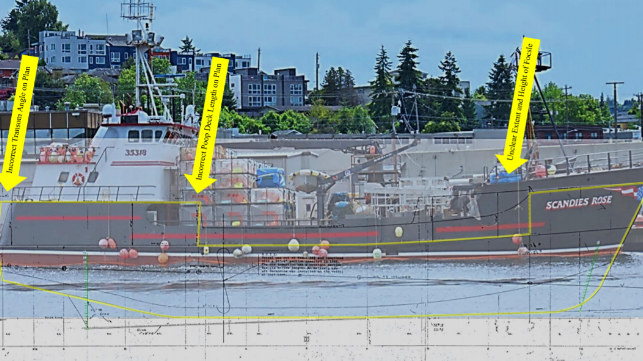USCG: Poor Calculations May Have Put Scandies Rose in Harm's Way

The fishing vessel Scandies Rose went down in the Gulf of Alaska in rough weather in December 2019. Recent testimony at a Marine Board of Investigation hearing has focused on ice buildup - especially heavy accumulation on crab pots - as a potential causal factor in the sinking. However, an official stability assessment by the U.S. Coast Guard's Marine Safety Center suggests that inaccurate design calculations may have put Scandies Rose at risk before she ever left the dock.
"When modeled by MSC, the majority of [expected] loading conditions fail required stability criteria," the MSC concluded. "Hydrostatics modeling demonstrates that the estimated casualty voyage loading condition may have met the restrictions of the [naval architect's stability booklet], but failed regulatory stability criteria, including water on deck, intact stability, and severe wind and roll criteria."
On the night of December 31, 2019, the Scandies Rose departed from Kodiak, headed west to start her Bering Sea snow crab season. She had about 195 crab pots on deck, and they were not covered with tarps. Icing conditions were in the forecast.
At about 2200 hours, she took on a heavy list, and the master made a mayday call to the Coast Guard. Two crewmembers managed to don immersion suits and escape the deckhouse before the boat sank, and they were rescued by a USCG helicopter aircrew; five others - including the captain - were lost at sea.
According to the Marine Safety Center, the hydrostatics model that the naval architect provided for the vessel "did not accurately represent the Scandies Rose," for multiple reasons. MSC alleged that it did not accurately model poop deck or forecastle enclosed volume (top image), did not model the bulwarks, had significantly less superstructure windage than the actual vessel, appeared to have much different tank capacities than the vessel capacity plan, and neglected downflooding in calculations.
"When downflooding angles were added to the [naval architect's] hydrostatics model (as required by the stability criteria), four [expected] loading conditions failed to meet stability criteria in any combination of light ship characteristics or crab pot dimensions," wrote MSC. "Dramatically worse results are obtained when using MSC’s hydrostatics model . . . Potential casualty voyage conditions evaluated with MSC’s model each failed intact and severe wind and roll criteria. When using MSC’s calculated light ship characteristics [for] large crab pots, both casualty voyage conditions failed all stability criteria."
Further, MSC found that "significant errors" were made in both the original (1988) and most recent (2019) lightweight surveys. The results of the 2019 survey were "not supported by test notes," MSC said. The data appeared to indicate weight growth - potentially (but not conclusively) a result of vessel modifications over time. MSC's conclusions were limited by "low confidence" in the quality of the inclining test data.
In addition, MSC acknowledged a criticism leveled by expert witnesses during the hearings: that the IMO and Coast Guard design standards for icing may not match the reality for Alaska crab boats. "The magnitude and asymmetry of icing during the casualty voyage was likely different than the symmetric 1.3/0.65-inch-thick icing required for stability criteria evaluation by 46 CFR 28.550," wrote MSC. "This could have made stability worse than calculated during the casualty voyage."
